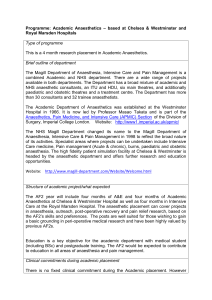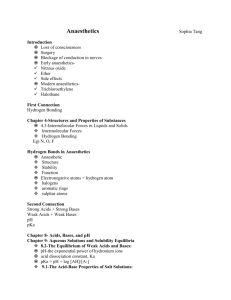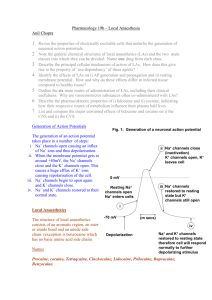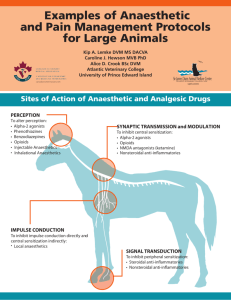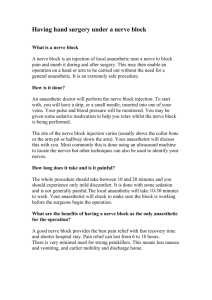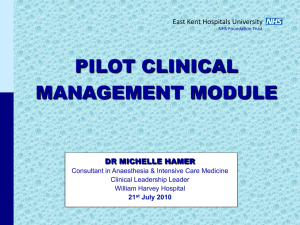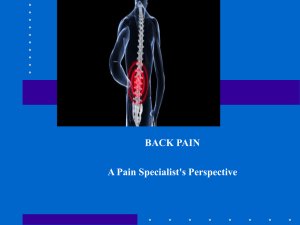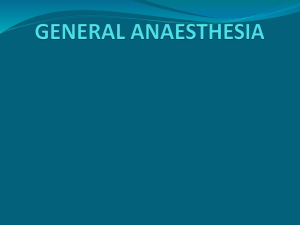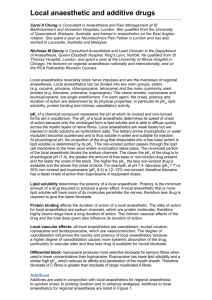Anaesthetics-Daniel and Christina - SCH4U1-05-2010
advertisement
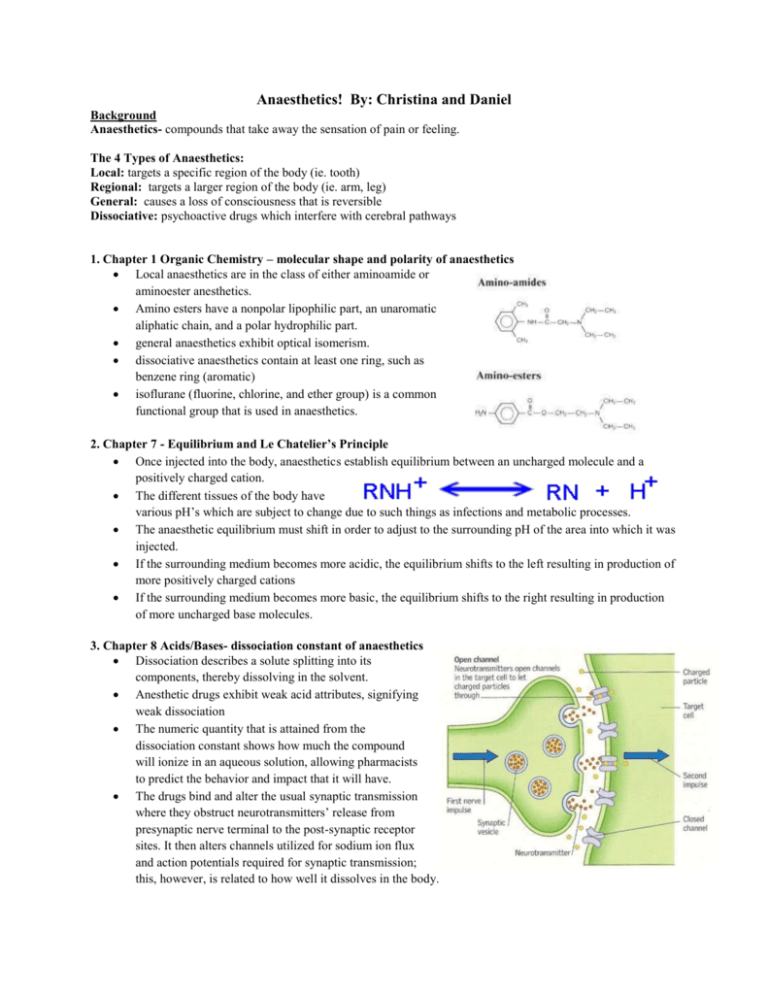
Anaesthetics! By: Christina and Daniel Background Anaesthetics- compounds that take away the sensation of pain or feeling. The 4 Types of Anaesthetics: Local: targets a specific region of the body (ie. tooth) Regional: targets a larger region of the body (ie. arm, leg) General: causes a loss of consciousness that is reversible Dissociative: psychoactive drugs which interfere with cerebral pathways 1. Chapter 1 Organic Chemistry – molecular shape and polarity of anaesthetics Local anaesthetics are in the class of either aminoamide or aminoester anesthetics. Amino esters have a nonpolar lipophilic part, an unaromatic aliphatic chain, and a polar hydrophilic part. general anaesthetics exhibit optical isomerism. dissociative anaesthetics contain at least one ring, such as benzene ring (aromatic) isoflurane (fluorine, chlorine, and ether group) is a common functional group that is used in anaesthetics. 2. Chapter 7 - Equilibrium and Le Chatelier’s Principle Once injected into the body, anaesthetics establish equilibrium between an uncharged molecule and a positively charged cation. The different tissues of the body have various pH’s which are subject to change due to such things as infections and metabolic processes. The anaesthetic equilibrium must shift in order to adjust to the surrounding pH of the area into which it was injected. If the surrounding medium becomes more acidic, the equilibrium shifts to the left resulting in production of more positively charged cations If the surrounding medium becomes more basic, the equilibrium shifts to the right resulting in production of more uncharged base molecules. 3. Chapter 8 Acids/Bases- dissociation constant of anaesthetics Dissociation describes a solute splitting into its components, thereby dissolving in the solvent. Anesthetic drugs exhibit weak acid attributes, signifying weak dissociation The numeric quantity that is attained from the dissociation constant shows how much the compound will ionize in an aqueous solution, allowing pharmacists to predict the behavior and impact that it will have. The drugs bind and alter the usual synaptic transmission where they obstruct neurotransmitters’ release from presynaptic nerve terminal to the post-synaptic receptor sites. It then alters channels utilized for sodium ion flux and action potentials required for synaptic transmission; this, however, is related to how well it dissolves in the body. 4. Chapter 6 - Rates of Reactions The anaesthetic in the form of uncharged molecules is able to diffuse through the nerve cell membrane. Once inside the membrane, the anaesthetic is re-equilibrated through a shift from the uncharged molecules to the positively charged cations. This shift causes more uncharged molecules to diffuse into the cell. The cations within the cell then bind with sodium carrier proteins, inhibiting the influx of sodium that would normally stimulate the nerve cell. Nerve conduction becomes limited, and this creates a feeling of numbness. The rate at which the anaesthetic sets in is affected by the pH of the surrounding tissue and the pKa of the anaesthetic itself. The pH of normal body tissue is 7.4 and therefore, the ideal pKa of anaesthetics for rapid diffusion of uncharged molecules would be 7.4. However, all local anaesthetics have a pKa greater than 7.4. The higher the pKa of the anaesthetic, the more the anaesthetic outside of the cell shifts to the production of cations to decrease the pH and so there is a lower concentration of uncharged molecules outside of the cell resulting in a slower diffusion into the cell and the slower the anaesthetic will set in. The higher the pKa of the anaesthetic, the slower the onset. 5. Chapter 8.1 - Properties of Acids and Bases Synthetic anesthetics are initially manufactured as weak bases (a substance that can accept a proton from an acid, the Bronsted-Lowry theory). An unstable precipitate is formed in the process, which is mixed with an acid in order to produce a salt. The salt is further combined with saline or water, yielding a stable solution. The anesthetic compounds now exhibit acidic qualities (a substance from which a proton can be removed, Bronsted-Lowry theory) 6. Chapter 11 - Galvanic Cells Galvanic cells have an electrical potential, causing electrons to move spontaneously from the anode, which has the higher potential energy, to the cathode, which has the lower potential energy. This process is akin to that of the movement of sodium and potassium ions in nerve cells. An electrochemical pressure gradient is set up between the fluid inside the axon and outside of the axon of a nerve cell. There are higher concentrations of sodium ions outside of the axon than within it and there are higher concentrations of potassium ions within the cell than outside. Although, technically there is no electrical potential difference, a spontaneous flow of ions from higher to lower concentrations occurs due to the pressure gradient. The flow of each type of ion can be compared to the flow of electrons in a galvanic cell. In both types of cells, a semi-permeable membrane must be present to allow the movement of ions. In galvanic cells this is a porous barrier or salt bridge. In nerve cells, this is a membrane. However, nerve cells must be stimulated for their membranes to be permeable and thus allowing depolarization to occur. Works Cited Encyclopaedia Britannica: (2011). Anesthetic. Retrieved May 5, 2011 from <http://www.britannica.com/EBchecked/topic/24338/anesthetic> Fisher, P., Le Couteur, P., Raap, R., & Rayner-Canham, G. (1989). Chemistry: A second Course. Canada: Addison-Wesley Publishers Limited Cherkas, A., Gaylor, J., Hayhoe, C., Jansen, P., Mustoe, F., Webb, M. (2002). Chemistry 12. Whitby: McGraw-Hill Ryerson Limited. Discovery Fit & Health: (2011). S. Freeman. How Anesthesia Works. Retrieved May 5, 2011 from <http://health.howstuffworks.com/medicine/surgeries-procedures/anesthesia.htm> Scientific American: (2011). How does anesthesia work? Retrieved May 8, 2011 from <http://www.scientificamerican.com/article.cfm?id=how-does-anesthesia-work&page=2> Dr. Spiller.com: (2000). The Local Anesthetics. Retrieved May 5, 2011, from <http://www.doctorspiller.com/local_anesthetics.htm>
